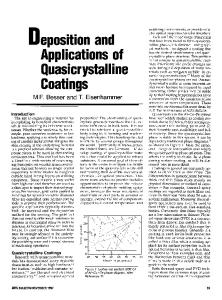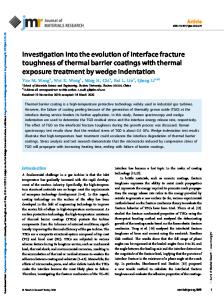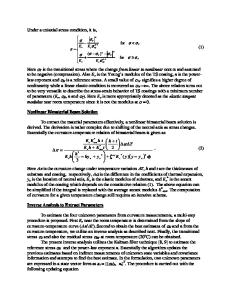Quasicrystalline coatings: Thermal evolution of structure and properties
- PDF / 2,319,262 Bytes
- 11 Pages / 612 x 792 pts (letter) Page_size
- 6 Downloads / 373 Views
D.J. Sordelet Department of Materials Science and Engineering, Department of Mechanical Engineering, and Ames Laboratory, Iowa State University, Ames, Iowa 50011
M.F. Besser Ames Laboratory, Iowa State University, Ames, Iowa 50011
D. Shechtman Department of Materials Engineering, Technion–Israel Institute of Technology, Haifa 32000, Israel
F.S. Biancaniello Metallurgy Division, National Institute of Standards and Technology, Gaithersburg, Maryland 20899
E.J. Gonzalez Ceramics Division, National Institute of Standards and Technology, Gaithersburg, Maryland 20899 (Received 12 January 2000; accepted 15 June 2000)
Quasicrystals (QCs) are known to exhibit unique properties as a result of their unique quasiperiodic structure. Real quasicrystalline (QC) materials, however, may exhibit complex phase structures, and as a consequence, their properties may differ from expectations. In the present work, QC coatings of the Al–Cu–Fe, Al–Cu–Fe–Cr, and Al–Pd–Mn systems were prepared by a plasma spray process, followed by heat treatments in the range 500–800 °C. The phase structure and evolution of the coatings were evaluated, and thermal diffusivity, hardness, and friction coefficient were measured. The presence of quasicrystalline and crystalline phases and their influence on these properties is systematically considered for the first time. Broadly, the coatings exhibit the properties expected of QC materials, low thermal diffusivity, high hardness, and low coefficients of friction, but it is also shown that these properties can be sensitive to the phase structure of the coatings. This suggests that phase structure may be manipulated by heat treatment to optimize the properties of QC coatings.
I. INTRODUCTION
It is well established that quasicrystals (QCs) exhibit unusual properties as a consequence of their unique quasiperiodic structure: much of current QC research is aimed at commercial exploitation of these properties. However, the widespread commercial utilization of QCs will require not only a knowledge of QC properties but also an understanding of QCs as engineering materials. In real QC materials, as in conventional engineering materials, variations from the ideal structure may result in departures from the expected properties. It is therefore necessary to understand the properties not only of ideal single-phase QCs but also of real QC materials. It is well known that the stability of QC phases can be sensitive to small compositional variations, so that QC phases are commonly observed in association with other phases, either quasicrystalline or crystalline or both. Further de1894
http://journals.cambridge.org
J. Mater. Res., Vol. 15, No. 9, Sep 2000 Downloaded: 13 Mar 2015
viations from a single-phase QC structure may be brought about by heat treatment. In spite of this, few studies have addressed the relationship between the phase structure of QC materials and their potentially useful properties. In the present work, we examine several QC materials of varying phase structure. Five QC coatings, based on Al–Cu–Fe
Data Loading...











